
visit-germany.info: the Mosel Valley
We started with the wines of the Rheingau or Rhine District, one of the oldest German wine regions where vines has been grown since Roman times. This is a unique region thanks to its geographical situation: for most of its length, the Rhine flows northwest, except near Mainz where it suddenly turns southwest for 20 miles, creating sunny, south-facing slopes that benefit from the heat-reflecting surface of the Rhine.
The wines we tasted:
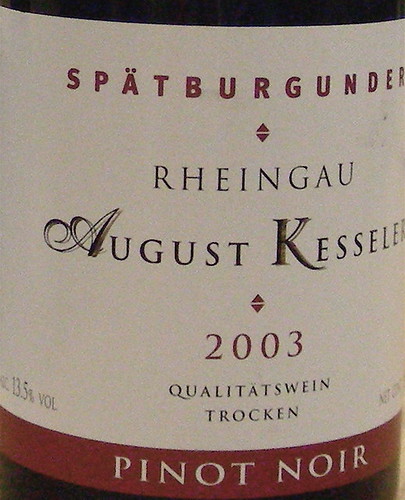 • 2003 August Kesseler Rheingau Spätburgunder Qualitatswein Trocken: August Kesseler not only makes Riesling but also Spätburgunder (Pinot Noir). He vinifies his Pinot Noir in the Burgundian style and uses French oak. This dry Pinot Noir (trocken) had a red-brick color and tart cherry aromas on the nose. The palate had upfront sweet fruit flavors, a light body, high acidity, and a light finish.
• 2003 August Kesseler Rheingau Spätburgunder Qualitatswein Trocken: August Kesseler not only makes Riesling but also Spätburgunder (Pinot Noir). He vinifies his Pinot Noir in the Burgundian style and uses French oak. This dry Pinot Noir (trocken) had a red-brick color and tart cherry aromas on the nose. The palate had upfront sweet fruit flavors, a light body, high acidity, and a light finish.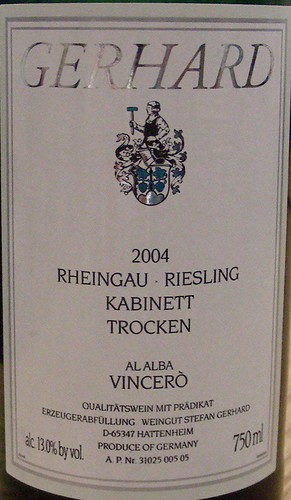 • 2004 Gerhard Al Alba Vincerò Riesling Kabinett: Stefan Gerhard loves making wine and loves music. Al alba vincerò! means At dawn I will win! and is a reference to Pucini's opera Turandot. He also uses glass Vino-Lok closures. The wine had a light golden color. The nose had floral, citrus, white peach and mineral aromas. The palate was slightly sweet and crisp, with honey and pear aromas on the finish. Overall, I found the wine light and easy.
• 2004 Gerhard Al Alba Vincerò Riesling Kabinett: Stefan Gerhard loves making wine and loves music. Al alba vincerò! means At dawn I will win! and is a reference to Pucini's opera Turandot. He also uses glass Vino-Lok closures. The wine had a light golden color. The nose had floral, citrus, white peach and mineral aromas. The palate was slightly sweet and crisp, with honey and pear aromas on the finish. Overall, I found the wine light and easy.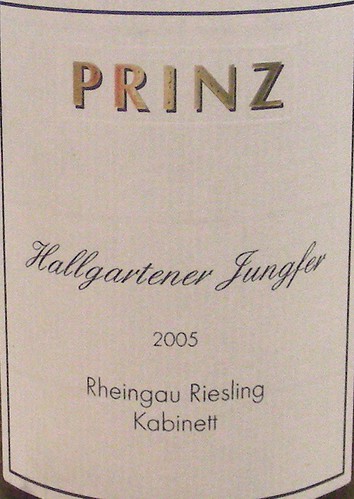 • 2005 Prinz Hallgartener Jungfer Riesling Kabinett: the Hallgartener Jungfer is one of the best vineyards of Weingut Fred Prinz. The wine had a straw color with green hue. On the palate, it was slightly fizzy, sweeter than the Gerhard with more body, and had a crisp, limey finish.
• 2005 Prinz Hallgartener Jungfer Riesling Kabinett: the Hallgartener Jungfer is one of the best vineyards of Weingut Fred Prinz. The wine had a straw color with green hue. On the palate, it was slightly fizzy, sweeter than the Gerhard with more body, and had a crisp, limey finish.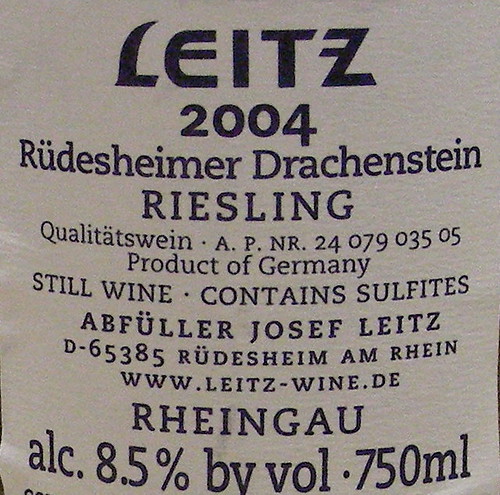 • 2004 Josef Leitz Rüdesheimer Drachenstein Dragonstone Riesling: Weingut Josef Leitz is a small estate of 5.8 hectares in Rüdesheim. It is one of the rising stars of the new generation of Rheingauers. The property's Dragonstone bottling is considered by many to be one of Germany's best Riesling values. The wine had a light yellow color and a nose of brown sugar. On the palate, it was mineral with a high level of acidity.
• 2004 Josef Leitz Rüdesheimer Drachenstein Dragonstone Riesling: Weingut Josef Leitz is a small estate of 5.8 hectares in Rüdesheim. It is one of the rising stars of the new generation of Rheingauers. The property's Dragonstone bottling is considered by many to be one of Germany's best Riesling values. The wine had a light yellow color and a nose of brown sugar. On the palate, it was mineral with a high level of acidity.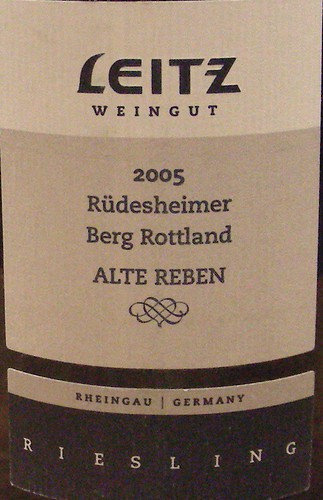 • 2005 Josef Leitz Rüdesheimer Berg Rottland Alte Reben Riesling: this wine comes from old vines (alte reben) from the Rüdesheimer Berg Rottland vineyard, one of the best sites of the Leitz estate. The wine had a deep golden color and a floral nose with notes of bitter orange marmalade. On the palate, the wine was rich and complex, and seemed drier than the Dragonstone. Definitively my favorite Rheingau wine!
• 2005 Josef Leitz Rüdesheimer Berg Rottland Alte Reben Riesling: this wine comes from old vines (alte reben) from the Rüdesheimer Berg Rottland vineyard, one of the best sites of the Leitz estate. The wine had a deep golden color and a floral nose with notes of bitter orange marmalade. On the palate, the wine was rich and complex, and seemed drier than the Dragonstone. Definitively my favorite Rheingau wine!We then moved to the wines of Mosel-Saar-Ruwer, which is today the most celebrated wine region of Germany, and is renowned for producing elegant wines with a fine acidity. The Mosel River and its tributaries, the Saar and Ruwer, have created dramatically steep, slaty slopes, covered with some of Germany's most famous vineyards. These slate-covered steep slopes heat up rapidly during the day when the sun shines, allowing the grapes to have a chance to mature properly. The soil, made of many stones and gravel, can easily absorb the falling rain and prevent erosion.
The wines we tasted: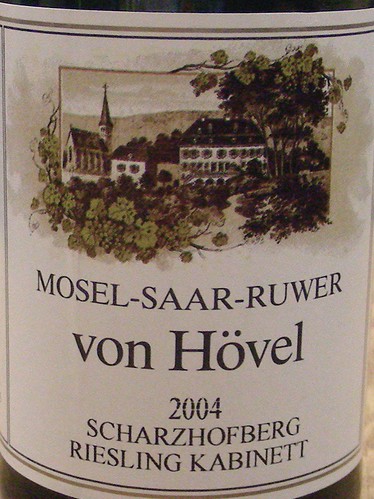 • 2004 von Hövel Scharzhofberg Riesling Kabinett: Weingut von Hövel is located in the Saar valley. The wine comes from the Scharzhofberg vineyard, a premier vineyard located near the village of Wiltingen along the saar River. It had a light yellow color with a greenish tone and an intense yeasty nose. On the palate, with just 8.5% of alcohol, it was light and juicy with a medium finish. Actually, a very pleasant wine.
• 2004 von Hövel Scharzhofberg Riesling Kabinett: Weingut von Hövel is located in the Saar valley. The wine comes from the Scharzhofberg vineyard, a premier vineyard located near the village of Wiltingen along the saar River. It had a light yellow color with a greenish tone and an intense yeasty nose. On the palate, with just 8.5% of alcohol, it was light and juicy with a medium finish. Actually, a very pleasant wine.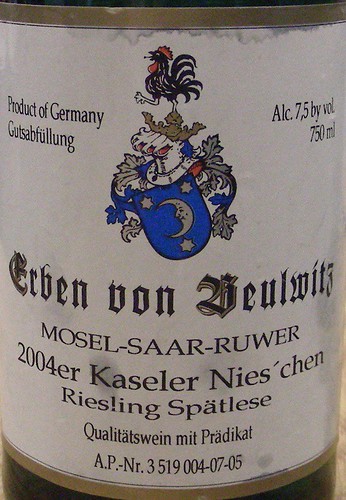 • 2004 Erben von Beulwitz Kaseler Nies'chen Riesling Spätlese: Weingut Erben von Beulwitz is located in the Ruwer valley and produces 90% Riesling on soil of decomposted slate. The estate's top sites include Kaseler Nies'chen and Kernagel. All vineyards face south/south-west. The Kaseler Nies'chen site is still planted with a majority of true rooted Riesling grapes, some over 100 years old. The wine had a deep golden color and a nose of pear and green apple. With just 7% alcohol, the palate was light-bodied with a mild finish. For some reason (the color?), I was expecting a fuller wine.
• 2004 Erben von Beulwitz Kaseler Nies'chen Riesling Spätlese: Weingut Erben von Beulwitz is located in the Ruwer valley and produces 90% Riesling on soil of decomposted slate. The estate's top sites include Kaseler Nies'chen and Kernagel. All vineyards face south/south-west. The Kaseler Nies'chen site is still planted with a majority of true rooted Riesling grapes, some over 100 years old. The wine had a deep golden color and a nose of pear and green apple. With just 7% alcohol, the palate was light-bodied with a mild finish. For some reason (the color?), I was expecting a fuller wine.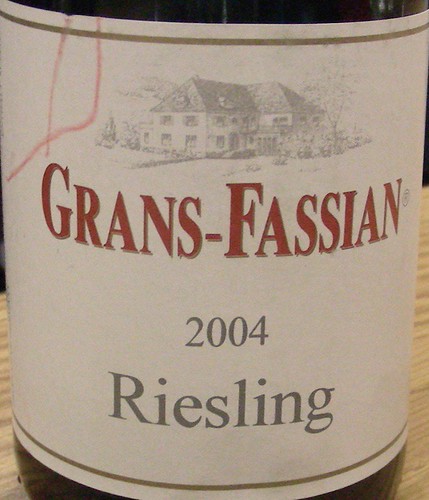 • 2004 Grans Fassian Riesling: The history of the Grans and Fassian families dates back to the 16th century. Today, the Grans-Fassian estate, which is located in Leiwen on the middle Mosel, owns ten hectares of some of the best vineyards around Leiwen, Trittenheim and Piesport. The wine had a straw color with a green tinge. It gave some tingly feeling on the tongue, leaving a slight bitterness, a balanced acidity, and a tasty honeyed finish.
• 2004 Grans Fassian Riesling: The history of the Grans and Fassian families dates back to the 16th century. Today, the Grans-Fassian estate, which is located in Leiwen on the middle Mosel, owns ten hectares of some of the best vineyards around Leiwen, Trittenheim and Piesport. The wine had a straw color with a green tinge. It gave some tingly feeling on the tongue, leaving a slight bitterness, a balanced acidity, and a tasty honeyed finish.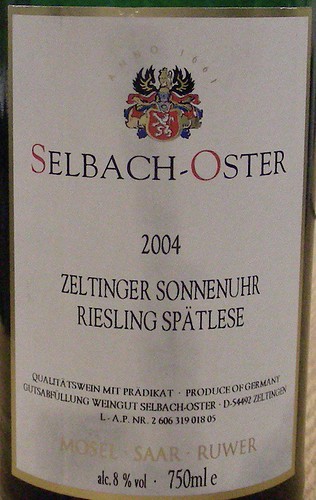 • 2004 Selbach-Oster Zeltinger Sonnenuhr Riesling Spätlese: The Mosel estate of Selbach-Oster has been owned by the Selbach family since 1661. It comprises a total of 16 hectares of vines including Germany's finest vineyards: Zeltinger Sonnenuhr, Wehlener Sonnenuhr, and Graacher Domprobst. These are planted entirely with Riesling, including some very old, ungrafted vines.
• 2004 Selbach-Oster Zeltinger Sonnenuhr Riesling Spätlese: The Mosel estate of Selbach-Oster has been owned by the Selbach family since 1661. It comprises a total of 16 hectares of vines including Germany's finest vineyards: Zeltinger Sonnenuhr, Wehlener Sonnenuhr, and Graacher Domprobst. These are planted entirely with Riesling, including some very old, ungrafted vines.
The Zeltinger Sonnenuhr vineyard, a very steep slope made of mostly stony blue slate mixed with some red slate, was named after the very large sundial (sonnenuhr) that had been installed on top of the Zeltinger site to allow vineyard workers to know the time of the day. The wine had a deep golden color with a hint of green hue. The nose was intense and the palate rich and complex with lingering notes of brown sugar on the finish. Maybe my favorite Mosel wine.
The last two wines from the Mosel were two Auslese from the same vineyard. But they were surprisingly very different.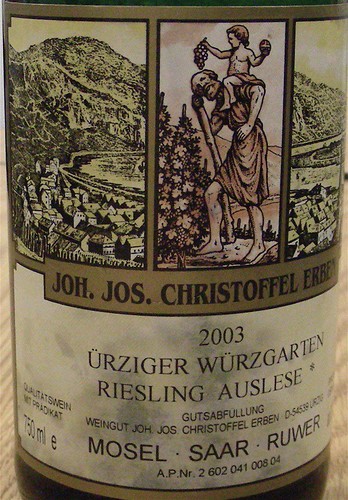 • 2003 Joh. Jos. Christoffel-Erben Ürziger Würzgarten Riesling Auslese*: the Joh. Jos. Christoffel-Erben estate is based in Ürzig, one of the Middle Mosel's great wine villages. It is particularly famous for its Würzgarten (spice garden) vineyard, named for its distinctive spiced wines. In Ürzig, the Mosel turns from a northerly direction to the east, creating steep, weathered slate slopes, with a gradient up to 70% in places. The wine had a deep golden color and an expressive and aromatic nose. On the palate, the wine was rich and full-bodied with a vivid freshness and a distinctive flavor of Chartreuse liqueur.
• 2003 Joh. Jos. Christoffel-Erben Ürziger Würzgarten Riesling Auslese*: the Joh. Jos. Christoffel-Erben estate is based in Ürzig, one of the Middle Mosel's great wine villages. It is particularly famous for its Würzgarten (spice garden) vineyard, named for its distinctive spiced wines. In Ürzig, the Mosel turns from a northerly direction to the east, creating steep, weathered slate slopes, with a gradient up to 70% in places. The wine had a deep golden color and an expressive and aromatic nose. On the palate, the wine was rich and full-bodied with a vivid freshness and a distinctive flavor of Chartreuse liqueur.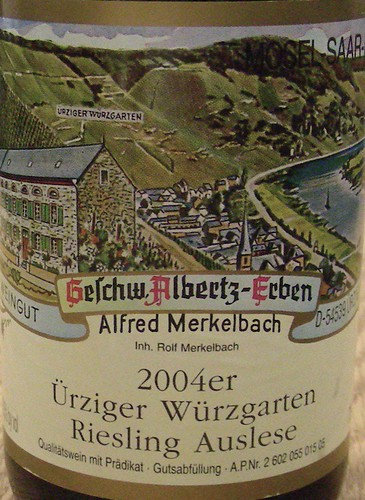 • 2004 Alfred Merkelbach Ürziger Würzgarten Riesling Auslese: the label is a colorful drawing of the vineyard itself. The wine had a nose that seemed, at the beginning, less developed than the Christoffel-Erben. It seemed also sweeter and heavier. With a little more time in the glass, the wine opened up nicely, revealing a richer mix of aromas, although I still preferred the distinctiveness and elegance of the Christoffel-Erben.
• 2004 Alfred Merkelbach Ürziger Würzgarten Riesling Auslese: the label is a colorful drawing of the vineyard itself. The wine had a nose that seemed, at the beginning, less developed than the Christoffel-Erben. It seemed also sweeter and heavier. With a little more time in the glass, the wine opened up nicely, revealing a richer mix of aromas, although I still preferred the distinctiveness and elegance of the Christoffel-Erben.
We tasted only one wine from the Mittelrhein. This wine region begins just below Bonn and continues south for about 60 miles on both banks of the Rhine. This is a land of ancient Rhine legends, medieval castles, and steep, terraced vineyards. Riesling, Müller-Thurgau and Kerner grow best on these inhospitable slopes but in years when grapes do not fully ripen, they are usually sold to Sekt — Germany's sparkling wine — producers.
The wine we tasted: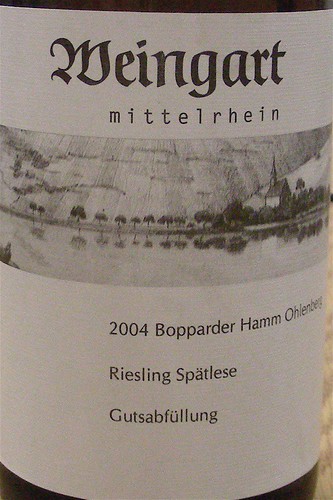 • 2004 Weingart Bopparder Hamm Ohlenberg Riesling Spätlese: a rising star on the Mittelrhein, Weingut Weingart is a 9 hectares estate and Bopparder Hamm Ohlenberg is one of its best sites. The wine had a golden color and a citrus and mineral nose. On the palate, it was sweet with a mild aftertaste and I thought, less distinctive flavors than the Mosel wines that we tasted earlier.
• 2004 Weingart Bopparder Hamm Ohlenberg Riesling Spätlese: a rising star on the Mittelrhein, Weingut Weingart is a 9 hectares estate and Bopparder Hamm Ohlenberg is one of its best sites. The wine had a golden color and a citrus and mineral nose. On the palate, it was sweet with a mild aftertaste and I thought, less distinctive flavors than the Mosel wines that we tasted earlier.
Coming next: wines from the Nahe, Rheinhessen, and Pfalz regions.
Technorati tags: wine food & drink
9 comments:
Thank you for your TNs. Riesling is one of my wine passions. From the many riesling-producing regions, I find Mosel-Saar-Ruwer to be my favorite. A close second is, for the moment, the Marlborough region of NZ.
Phyll, have you tried Austrian Rieslings?
Thanks, Catherine. I'm glad you found some good notes on the wines, as I was such in a rush to get them that I didn't have time to pull out all the info. And the folks at Dee Vine Wines told me Al Alba Vincero was from a Verdi opera, so I'm glad you found the original.
that's what I like about wine, there's so much culture behind a mere bottle of wine!
Selbach-Oster Zeltinger Sonnenuhr Riesling Spätlese: This is the German wine, of various vintages, that I've bought/drunk the most. It's their best vineyard and I love the balance of acids and sweetness. I think I started with 18 bottles of their 1992 vintage of this wine.
Austrian wines are still underexplored by me. I've only had one riesling and a few Grüner Veltliner. I can't remember the producer of the riesling that I had...it was from Wachau, though.
What is your opinion on Austrian rieslings, and perhaps you could recommend some names to me?
Phyll,
I remember that I particularly liked the Weingut Schmelz Durnsteiner Freiheit Riesling Smaragd, the Nigl Riesling Privat and the Johann Topf Zobinger Riesling.
Thank you for your recco, Catherine. I will look around for those producers' wines.
I just found your blog while googling for Joh. Jos. Christoffel Erban Reisling 2004 "J. J." I''m not familiar with this wine and can find no reviews that hit on that the J.J. label. I am assuming it is one of the winery's more common wines, and not a top shelf offering. Are you familiar with it?
Also, since you seem to know about wine, I was surprised to see that certain vintages of rieslings could be laid down for drinking in the future. I think the dates quoted went out to 2020-2022. I didn't think whites matured with age and that aging only referred to reds. Any thoughts?
Post a Comment